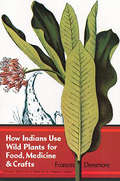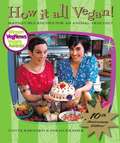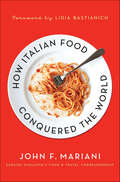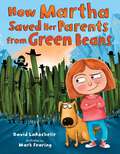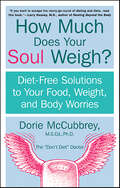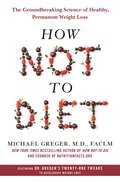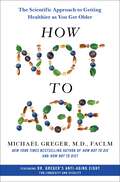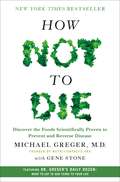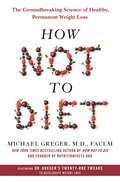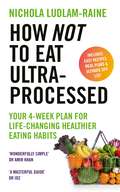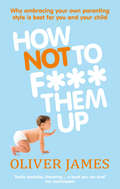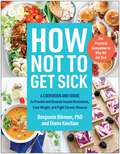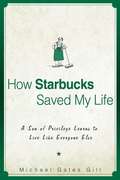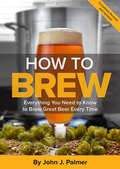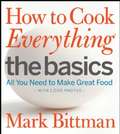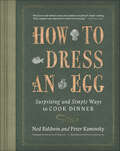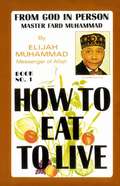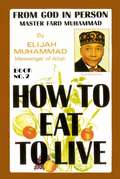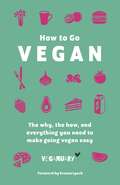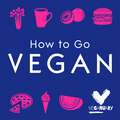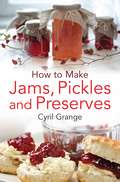- Table View
- List View
How Indians Use Wild Plants for Food, Medicine & Crafts
by Frances Densmore"Learn the natural ways of the Chippewa Indians with this great book from Dover." — Texas Kitchen and Garden and MoreThe uses of plants — for food, for medicine, for arts, crafts, and dyeing — among the Chippewa Indians of Minnesota and Wisconsin show the great extent to which they understood and utilized natural resources. In this book those traditions are captured, providing a wealth of new material for those interested in natural food, natural cures, and native crafts.In separate sections describing the major areas of use, Miss Densmore, an ethnologist with the Smithsonian Institution, details the uses of nearly 200 plants with emphasis on wild plants and lesser-known uses. For those interested in natural foods she gives extensive coverage to the gathering and preparation of maple sugar and wild rice, as well as preparations for beverages from leaves and twigs of common plants, seasonings including mint and bearberry, the methods of preparing wild rice and corn, cultivated and wild vegetables, and wild fruits and berries. On Indian medicines she tells the basic methods of gathering plants and the basic surgical and medical methods. Then she gives a complete list of the plants with their botanical names, uses, parts used, preparation and administration, and other notes and references. Also covered are plants used as charms, plants used in natural dyes, and plants in the useful and decorative arts including uses for household items, toys, mats, twine, baskets, bows, and tools, with special emphasis on the uses of birch bark and cedar. This section will be especially useful for supplying new and unusual craft ideas. In addition, 36 plates show the many stages of plant gathering and preparation and many of the artistic uses. While a number of the plants discussed are native only to the Great Lakes region, many are found throughout a wide range.Those studying the Indians of the Great Lakes region, or those trying to get back to nature through understanding and using natural materials, will find much about the use of plants in all areas of community life. Because of Miss Densmore’s deep knowledge and clear presentation, her study remains a rich and useful source for learning about or using native foods, native cures, and native crafts.
How It All Vegan! 10th Anniversary Edition
by Sarah Kramer Tanya BarnardSince it was first published in 1999, How It All Vegan! has become a bible for vegan cooks, both diehard and newly converted; its basic introduction to the tenets of vegan living and eating, combined with Sarah Kramer's and Tanya Barnard's winning charm, made it an essential cookbook for anyone considering eschewing animal products from their diet. It won VegNews' Veggie Award for Best Cookbook twice, has been reprinted fourteen times, and spawned several successful sequels (including The Garden of Vegan, La Dolce Vegan!, and last year's Vegan à Go-Go!). In the ten years since How It All Vegan! was first published, however, veganism has "come out of the closet," and is now considered a legitimate diet and lifestyle not only for those wishing to improve their health, but also for those who care deeply about the welfare of animals. This tenth-anniversary edition includes a new color photo section and new recipes; it also includes a new introduction by co-author Sarah Kramer, who speaks personally and passionately about the impact of veganism on her life over the past decade.
How Italian Food Conquered the World
by John F. MarianiNot so long ago, Italian food was regarded as a poor man's gruel-little more than pizza, macaroni with sauce, and red wines in a box. Here, John Mariani shows how the Italian immigrants to America created, through perseverance and sheer necessity, an Italian-American food culture, and how it became a global obsession. The book begins with the Greek, Roman, and Middle Eastern culinary traditions before the boot-shaped peninsula was even called "Italy," then takes readers on a journey through Europe and across the ocean to America alongside the poor but hopeful Italian immigrants who slowly but surely won over the hearts and minds of Americans by way of their stomachs. Featuring evil villains such as the Atkins diet and French chefs, this is a rollicking tale of how Italian cuisine rose to its place as the most beloved fare in the world, through the lives of the people who led the charge. With savory anecdotes from these top chefs and restaurateurs: - Mario Batali- Danny Meyer- Tony Mantuano- Michael Chiarello- Giada de Laurentiis- Giuseppe Cipriani- Nigella LawsonAnd the trials and triumphs of these restaurants:- Da Silvano- Spiaggia- Bottega- Union Square Cafe- Maialino- Rao's- Babbo- Il Cantinori
How Martha Saved Her Parents from Green Beans
by David LaRochelleMartha HATES green beans. When some mean, green bandits stroll into town, anyone who ever said "Eat your green beans" is in big trouble. But when the beans kidnap Martha's parents, Martha is forced to take action. She can think of only one way to stop the villainous veggies from taking over her town, and it&’s not pretty...or tasty. Featuring absurdly funny text and illustrations with attitude, this is a hilarious read for everyone – even the pickiest of eaters.
How Much Does Your Soul Weigh?: Diet-Free Solutions to Your Food, Weight, and Body Worries
by Dorie McCubbreyYou hold in your hands a life-changing weight control revelation -- a holistic approach to help you overcome all eating and weight problems from anorexia to obesity. This innovative book will shed light on your unsuccessful attempts at dieting and help you begin to heal from the inside out, once and for all!How many "miracle diets" have you tried? How many minutes and hours have you spent worrying about the numbers on the bathroom scale? How many times have you lost weight only to gain it back along with renewed disappointment and frustration? You've worried about how much your body weighs, but have you asked: How Much Does Your Soul Weigh?Dr. Doric McCubbrey, a weight-issues specialist whose practice boasts a 95 percent success rate, reveals that the weight of your soul may be preventing you from effecting the changes you want to see in your appearance and self-esteem. By starting Dr. Dorie's plan for "Intuitive Self-Care," you can begin to unburden your soul of all the "weighty attitudes" of the diet mentality -- rigid rules, negative self-talk, and unrealistic goals -- that lead to very real feelings of disappointment and hopelessness.With empathy and insight, Dr. Doric explores and explains the importance of a soulful attitude toward your eating, exercise, and weight. You'll discover:the "games" dieters play -- and why none of them worksthe four archetypal weight problems and how to overcome them for goodthe secrets of naturally thin people -- and how you can incorporate them into your lifea 30-day plan of therapeutic "recipes" designed especially to nourish your soulPacked with stories from Dr. Dorie's own 15-year struggle with overeating, anorexia, and bulimia, and the experiences of her clients, How Much Does Your Soul Weigh? shows you how to generate the happiness, health, balance, and confidence that will put your weight worries to rest for good!
How Not To Diet: Discover The Groundbreaking Science Of Weight Loss
by Michael GregerEvery month seems to bring a trendy new diet or weight loss fad—and yet obesity rates continue to rise, and with it a growing number of diseases and health problems. It’s time for a different approach. Enter Dr. Michael Greger, the internationally-renowned nutrition expert, physician, and founder of the Nutrition Facts website. Author of the mega bestselling How Not to Die, Dr. Greger now turns his attention to the latest research on the leading causes—and remedies—of obesity. Dr. Greger hones in on the optimal criteria to enable weight loss, while considering how these foods actually affect our health and longevity. He lays out the key ingredients of the ideal weight-loss diet—factors such as calorie density, the insulin index, and the impact of foods on our gut microbiome—showing how plant-based eating is crucial to our success. But How Not to Diet goes beyond food to identify twenty-one weight-loss accelerators available to our bodies, incorporating the latest discoveries in cutting-edge areas like chronobiology to reveal the factors that maximize our natural fat-burning capabilities. Dr. Greger builds the ultimate weight loss guide from the ground up, taking a timeless, proactive approach that can stand up to any new trend. Chock full of actionable advice and groundbreaking dietary research, How Not to Diet will put an end to dieting—and replace those constant weight-loss struggles with a simple, healthy, sustainable lifestyle.
How Not to Age: The Scientific Approach to Getting Healthier as You Get Older
by Michael Greger M.D.Instant New York Times BestsellerUncover the evidence-based science to slowing the effects of aging, from the New York Times bestselling author of the How Not to Die series When Dr. Michael Greger, founder of NutritionFacts.org, dove into the top peer-reviewed anti-aging medical research, he realized that diet could regulate every one of the most promising strategies for combating the effects of aging. We don’t need Big Pharma to keep us feeling young—we already have the tools. In How Not to Age, the internationally renowned physician and nutritionist breaks down the science of aging and chronic illness and explains how to help avoid the diseases most commonly encountered in our journeys through life.Physicians have long treated aging as a malady, but getting older does not have to mean getting sicker. There are eleven pathways for aging in our bodies’ cells and we can disrupt each of them. Processes like autophagy, the upcycling of unusable junk, can be boosted with spermidine, a compound found in tempeh, mushrooms, and wheat germ. Senescent “zombie” cells that spew inflammation and are linked to many age-related diseases may be cleared in part with quercetin-rich foods like onions, apples, and kale. And we can combat effects of aging without breaking the bank. Why spend a small fortune on vitamin C and nicotinamide facial serums when you can make your own for up to 2,000 times cheaper?Inspired by the dietary and lifestyle patterns of centenarians and residents of “blue zone” regions where people live the longest, Dr. Greger presents simple, accessible, and evidence-based methods to preserve the body functions that keep you feeling youthful, both physically and mentally. Brimming with expertise and actionable takeaways, How Not to Age lays out practical strategies for achieving ultimate longevity.
How Not to Die: Discover the Foods Scientifically Proven to Prevent and Reverse Disease, First Edition
by Gene Stone Michael GregerIn How Not to Die, Dr. Michael Greger, the internationally-renowned nutrition expert, physician, and founder of NutritionFacts.org, examines the fifteen top causes of premature death in America-heart disease, various cancers, diabetes, Parkinson's, high blood pressure, and more-and explains how nutritional and lifestyle interventions can sometimes trump prescription pills and other pharmaceutical and surgical approaches, freeing us to live healthier lives.
How Not to Diet: The Groundbreaking Science of Healthy, Permanent Weight Loss
by Michael Greger M.D.Discover the cutting-edge science behind long-term weight loss success, in this powerful new book from the New York Times bestselling author of How Not to Die.Every month seems to bring a trendy new diet or weight loss fad—and yet obesity rates continue to rise, and with it a growing number of diseases and health problems. It’s time for a different approach.Enter Dr. Michael Greger, the internationally-renowned nutrition expert, physician, and founder of Nutrition Facts website. Author of the mega bestselling How Not to Die, Dr. Greger now turns his attention to the latest research on the leading causes—and remedies—of obesity. Dr. Greger hones in on the optimal criteria to enable weight loss, while considering how these foods actually affect our health and longevity. He lays out the key ingredients of the ideal weight-loss diet—factors such as calorie density, the insulin index, and the impact of foods on our gut microbiome—showing how plant-based eating is crucial to our success.But How Not to Diet goes beyond food to identify twenty-one weight-loss accelerators available to our bodies, incorporating the latest discoveries in cutting-edge areas like chronobiology to reveal the factors that maximize our natural fat-burning capabilities. Dr. Greger builds the ultimate weight loss guide from the ground up, taking a timeless, proactive approach that can stand up to any new trend. Chock full of actionable advice and groundbreaking dietary research, How Not to Diet will put an end to dieting—and replace those constant weight-loss struggles with a simple, healthy, sustainable lifestyle.
How Not to Eat Ultra-Processed: Your 4-week plan for life-changing healthier eating habits
by Nichola Ludlam-RaineWe know we should eat fewer ultra-processed foods; this book shows you how to do it.From expert dietitian, Nichola Ludlam-Raine, comes this simple, easy-to-follow plan for reducing the ultra-processed foods in your diet.Taking you through 4 weeks, each focused on a different meal (snacks and drinks, breakfast, lunch and dinner), Nichola equips you with the practical ways you can make a huge difference to your diet through small, achievable changes.Along the way she also debunks the myths that surround ultra-processed foods and provides answers to the most commonly asked questions, to help soothe anxiety around what you eat and enable you to feel confident with what's on your plate, wherever you are and whatever time of the day.With recipes to get you started and a comprehensive list of over 100 processed and ultra-processed foods, ranked according to their nutritional benefits and with guidance on how often you should eat them, this is a necessary guide for anyone looking to eat healthier and make a real change to their long-term health.
How Not to F*** Them Up
by Oliver JamesAs a mother, are you comfortable in your skin?Want to know how best to be a stay-at-home or working mum?Babies have very simple needs, yet many parents are overwhelmed with elaborate advice on how to meet them. In How Not to F*** Them Up, leading child psychologist Oliver James argues that your under-threes do not need training; it's getting your head straight as a parent that's important.Drawing on extensive interviews and the lastest clinical research, James identifies three basic types of mum: the Hugger, the Organiser and the Fleximum. Outlining the benefits and pitfalls of each, How Not to F*** Them Up shows you how to recognise which style suits you best and outlines simple strategies to reconcile personal ambitions with the needs of your family.Empowering and provocative, Oliver James will help you make the best choices for bringing up a happy, confident child.
How Not to Get Sick: A Cookbook and Guide to Prevent and Reverse Insulin Resistance, Lose Weight, and Fight Chronic Disease
by Diana Keuilian Benjamin BikmanPrevent illness, reach your ideal weight, and feel better than ever with the ultimate cookbook and lifestyle guide companion to Why We Get Sick, from internationally renowned scientist Benjamin Bikman and fitness coach and recipe developer Diana Keuilian With his breakout book Why We Get Sick, Benjamin Bikman helped thousands of people to understand insulin resistance: what it is, why it happens, how it affects nearly every system in our bodies. Now, in this companion guide featuring 70 low-carb and keto-friendly recipes, Bikman has teamed up with the fitness expert and recipe developer Diana Keuilian to help the nearly 9 in 10 American adults affected with insulin resistance. Together, they translate the latest research into actionable, easy-to-follow steps. You can make dramatic improvements in your insulin sensitivity, resist chronic illness, attain a healthy weight, and improve your energy. In part one, learn how to assess your health with regards to insulin resistance and understand the science. In part two, discover a three-pronged approach to reversing insulin resistance or maintaining insulin sensitivity. And in part three, get the tools to put the plan into action, with exercise, meal plans for intermittent fasting, and healthful recipes that the whole family will love, including: BBQ Pulled Pork Sliders Mediterranean Turkey Bowls Easy Chicken Enchilada Casserole Meatzza Pizza Crispy Sweet Mongolian Beef Adobo Braised Mushroom Tacos Sizzling Crab Cakes Vegetarian White Garlic Lasagna Cheesy Garlic Breadsticks Frosted Fudge Brownies Iced Apple Cinnamon Muffins Illustrated with stunning full-color photography and chock-full of knowledge and encouragement, How Not to Get Sick is an essential resource for healthy living.
How Pizza Came to Queens
by Dayal Kaur KhalsaAn Italian visitor to Queens bemoans the unavailability of pizza until some thoughtful girls enable her to make some.
How Starbucks Saved My Life: A Son of Privilege Learns to Live Like Everyone Else
by Michael Gates GillThe riches-to-rags story of a middle-aged man who lost his good job and how he manages to get back humility and confidence by working at Starbucks.
How To Brew: Everything You Need to Know to Brew Great Beer Every Time
by John J. PalmerHow to Brew is the definitive guide to making quality beers at home. Whether you want simple, sure-fire instructions for making your first beer, or you&’re a seasoned homebrewer working with all-grain batches, this book has something for you. John Palmer adeptly covers the full range of brewing possibilities—accurately, clearly and simply. From ingredients and methods to recipes and equipment for brewing beer at home, How to Brew is loaded with valuable information on brewing techniques and recipe formulation.A perennial best seller since the release of the third edition in 2006, How to Brew, is a must-have to update every new and seasoned brewer&’s library.This completely revised and updated edition includes:More emphasis on the &“top six priorities&”: sanitation, fermentation temperature control, yeast management, the boil, good recipes, and water.Five new chapters covering malting and brewing, strong beers, fruit beers, sour beers, and adjusting water for style.All other chapters revised and expanded:Expanded and updated charts, graphs, equations, and visuals.Expanded information on using beer kits.Thorough revision of mashing and lautering chapters:Expanded tables of recommended times and temperatures for single-infusion, multiple-step, and decoction mashing.Complete discussion of first wort gravity as a function of water to grist ratio.Complete revision of infusion and decoction equations.Revised and updated information on managing your fermentation:Yeast pitching and starters. Yeast starter growth factors.Yeast and the maturation cycle.And much more!
How To Clean Everything: The Authoritative Guide to Cleaning, Conditioning and Stain Removal for Every Type of Material and Surface (3rd Edition)
by Alma Chesnut MooreFrom the book: HOW TO CLEAN EVERYTHING is a comprehensive guide to cleaning any material, removing any stain and caring for any object. This manual, now available from JOB SQUAD, will become so indispensable, you will wonder how you ever managed to clean a home without it! Among the hundreds of tips offered are: Remove chewing gum (if water does not spot the material) by rubbing the gummy portion with a piece of ice. Then you can scrape or rub the gum out of the fabric. Clean a diamond ring by boiling mild soapsuds with a few drips of ammonia added, immersing the ring, dipping it into a small bowl of alcohol, and letting it dry on tissue paper. Remove fresh coffee and tea stains (if it's safe for the fabric) by stretching the stained portion of cloth over an open bowl and securing it with a rubber band. From a height of 1 to 3 feet, pour boiling water over the cloth. From awnings to Venetian blinds, cashmere to silk, coral to vinyl, HOW TO CLEAN EVERYTHING provides the best methods for ensuring a long and beautiful life for your belongings.
How To Cook Everything The Basics: All You Need to Make Great Food--With 1,000 Photos (Giver Quartet Ser. #4)
by Mark BittmanAll You Need to Make Great Food
How To Dress An Egg: Surprising and Simple Ways to Cook Dinner
by Peter Kaminsky Ned Baldwin“This collection of varied and delicious suggestions for dressing up basic key recipes is recommended for home cooks looking to add some flair to . . . meals.” —Library JournalLearn to cook one thing exceptionally well and you open the door to a multitude of possibilities, with no need for special equipment or fussy techniques.Ned Baldwin, a home cook who taught himself to be an excellent chef, sees no reason why anyone else can’t do the same. By showcasing one ingredient per method, Baldwin introduces all the skills a cook will ever need to prepare endless pleasurable meals. Get a big, beefy hit from a hanger steak by cooking it in the oven; master salad-making with leafy greens; grill fillets of sea bass for crispy skin and moist flesh; roast an explosively juicy chicken; bake leeks to soft perfection; and more.Each dish is elaborated on in different ways to expand the technique into unlikely, inventive recipes that are jumping-off points for endless creativity.“One has to cook with precision and confidence to pull off ‘simple’ cooking. Ned’s common sense approach is evident on every page.” —Tom Colicchio James Beard award–winning chef and Emmy-award winning producer of Top Chef“This book will make you hungry and happy.” —Ruth Reichl, James Beard award–winning food writer and editor and chief of Gourmet magazine “Keep this book close—you’ll be consulting it often.” —Dorie Greenspan, James Beard award–winning author of Everyday Dorie“A secret treasure, full of tweaks and twists for rendering familiar-seeming dishes into delicious food.” —Bill Buford, national bestselling author of Heat “Instills confidence, and even injects a bit of fun into the food preparation.” —Booklist
How To Eat To Live, Book 1
by Elijah MuhammadBefore the health craze that has swept the country, Elijah Muhammad and the Nation of Islam were head of the curve as far back as the early 30's. This is the first of two books written with this simple, yet revolutionary way of eating.
How To Eat To Live: Book 2
by Elijah MuhammadFor more than 30 years, messenger Elijah Muhammad has been teaching the so-called Negroes of America on the proper foods to eat to improve their mental power, physical appearance, for prevention of illness, curing of ailments and prolonging life. Given the humble, economic conditions of the blacks in America, an inexpensive, yet highly nutritional diet was given to them by Elijah Muhammad. Before the health craze that has swept the country, Elijah Muhammad and the Nation of Islam were head of the curve as far back as the early 30's. This is the second of two books written with this simple, yet revolutionary way of eating.
How To Go Vegan: The why, the how, and everything you need to make going vegan easy
by VeganuaryGoing vegan is easy!Whether you're already a full-time vegan, considering making the switch or know someone who is, this book will give you all the tools you need to make the change towards a healthier, happier and more ethical lifestyle. How to Go Vegan includes...Why try vegan?Animal welfare, the environment, health benefits and your personal adventure.Vegan at homeSurprisingly vegan foods, reading labels, vegan ingredient essentials, easy replacements, how to be the only vegan in the familyVegan out in the worldEating out, eating at friends' houses, answering questions from loved ones, travelling veganLiving the vegan lifestyleMeal plans, tips and tricks, what to do if you're struggling, how to celebrate being a veganHow to go vegan. It's easier than you think.
How To Go Vegan: The why, the how, and everything you need to make going vegan easy
by VeganuaryEver thought about eating less meat and fewer dairy products? Concerned about animal welfare and the environment? Interested in the health benefits of a plant-based lifestyle? This is the book for you. In this fun, easy to follow and informative guide, the team behind the charity Veganuary provide everything you need to make changes towards leading a healthier, more ethical and sustainable lifestyle. From your motivations, tips for eating out, easy substitutions and making sure you get the right nutrients, this book is a lifesaver for vegans, those wanting to give veganism a try, or for friends and family. Try going vegan for one month - with How To Be Vegan it is easier than you think.
How To Go Vegan: The why, the how, and everything you need to make going vegan easy
by Veganuary Trading LimitedA short guide to going vegan - the why, the what and the how.Ever thought about eating less meat and fewer dairy products? Concerned about animal welfare and the environment? Interested in the health benefits of a plant-based lifestyle? This is the book for you. In this fun, easy to follow and informative guide, the team behind the charity Veganuary provide everything you need to make changes towards leading a healthier, more ethical and sustainable lifestyle. From your motivations, tips for eating out, easy substitutions and making sure you get the right nutrients, this book is a lifesaver for vegans, those wanting to give veganism a try, or for friends and family. Try going vegan for one month - with How To Be Vegan it is easier than you think.(P)2017 Hodder & Stoughton
How To Make Jams, Pickles and Preserves
by Cyril GrangeFor the a novice this book provides the principles of successful jam making and for the more experienced jam maker there are recipes, not only for the usual fruit and vegetables but for more unusual combinations of flavours. The recipes in this book are reliable and have been formulated by much research and experimentation in the author?s kitchen, and from recipes for proven value from skilled housewives over many years.
How To Make Jams, Pickles and Preserves
by Cyril GrangeThis comprehensive book contains all you need to know to make your own jam and other preserves.Whether you're a novice preserver or an expert jam-maker, this book provides the principles of successful jam making as well as recipes, not only for the usual fruit and vegetables but for more unusual combinations of flavours. The recipes in this book are reliable and have been formulated by much research and experimentation in the author's kitchen, and from recipes for proven value from skilled housewives over many years.
